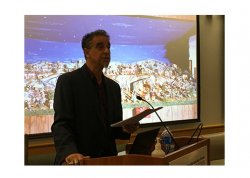Enthusiastic Responses to Dr. Sciorra’s Book Presentation (2/23)
Posted in: Inserra, Italian News and Events

A full house welcomed Dr. Sciorra (Director for Academic and Cultural Programs at the John D. Calandra Italian American Institute, Queens College) on February 23 for the presentation of his book Built with Faith: Italian American Imagination and Catholic Material Culture in New York City (University of Tennessee Press, 2015), organized by the Department of History, co-organized and sponsored by The Inserra Chair in Italian and Italian American Studies (Department of Spanish and Italian) with the cosponsorship of The College of Humanities and Social Sciences and The Coccia Institute for the Italian Experience in America at Montclair State University.
“The presentation gave students in my Italian American History and Culture course a deeper understanding of how ethnic identity is enacted through, in his example, practices such as the creation of yard shrines, presepi, and more,” explained Dr. Nancy Carnevale, (Department of History). “Some students were surprised that he was not advocating for the continuation of these traditions. Instead, his examples made it clear that cultural traditions are not fixed; immigrants and their descendants adapt traditions or create new ones that are meaningful to them in the present context. Students were also impressed that Sciorra took as his subject the seemingly ordinary–yard shrines, for example, are a familiar sight in many New York and New Jersey neighborhoods– and uncovered the profound meanings these practices hold for the people he interviewed.”
The audience was particularly mixed on this occasion as it included several members of the Italian American community, who regularly attend events organized by the Coccia Institute, and students who regularly come in large numbers to Inserra events. This time, a large contingent of high school students also attended: they were brought to campus by a graduate in Italian from Montclair State University, Gaetano Sollazzo.
“It was great to see my students in a college setting, where they were able to be a part of a very informative lecture about the topic that they are studying,” said Gaetano Sollazzo, teacher of Italian at Nutley High School. “I truly believe that it is imperative for our high school students to be involved in college led activities such as this one. The experience and knowledge that they gain is invaluable. In order to continue to grow Italian language and culture, we as educators must always strive to include our students as early as possible in this kind of events.”
Teresa Fiore, Inserra Chair, remarked that “this is one of the goals of these collaborative events, i.e. to bring high school students to our campus to enrich their current experience in view of their future one in higher education. That this was done on the occasion of a presentation about religion, folk art and the Italian identity in the U.S. shows the breadth and scope of Italian Program on campus. The Inserra Endowment that supports the Program is indeed devoted to both Italian and Italian American Studies and is by definition extremely interdisciplinary.”
The presentation piqued the curiosity of Serafina Genise, a student in Carnevale’s class: “I really wish I could have listened to him speak more in depth about everything he has seen over the years. The pictures and stories he shared made me want to read his book and find all these places and experience them first hand.” Another History student, Ray Taddeo, remarked: “Altars, yard shrines, and other religious art can be created and appreciated even by those who don’t believe in them. In this sense, cultural art should be appreciated by people of all backgrounds, social statuses, and beliefs. While Italian-American history is important to preserve, so is every other history in this nation of immigrants. Individuals can garner a better understanding of the cultural history of others while preserving their own.”
“I was very excited to see a particularly dynamic conversation between younger students and older community members in the audience. That exchange itself was very stimulating and it’s the kind of cultural and social environment that I appreciate,” concluded the presenter, Dr. Sciorra. “Talking about religion and vernacular artistry is not an easy topic for it is usually accompanied by prejudice and preconceptions and I hope my work will shine a light onto these religious expressions.”
